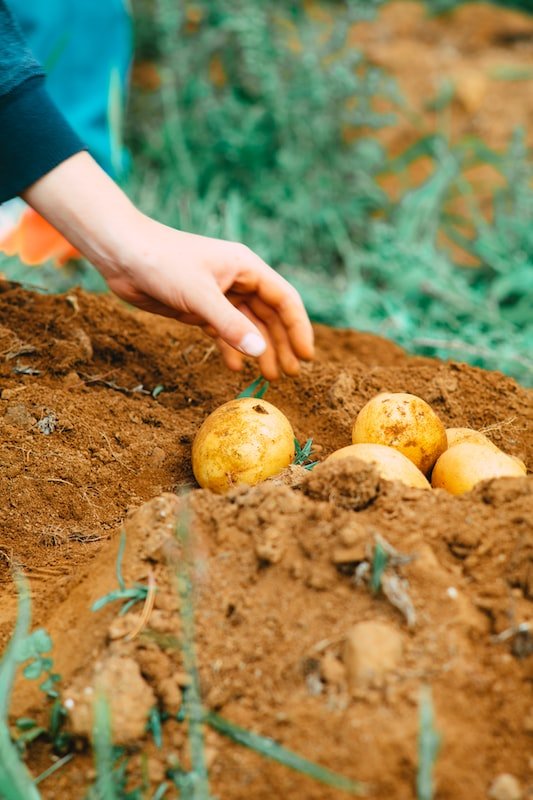The shelf life of potatoes is covered in detail here. Find out how long potatoes keep, how long cooked potatoes can sit in the fridge, and when to throw them out.
Have a bag of potatoes that have been kept in the pantry for longer than a week and are unsure of how long they will remain edible? How long are potatoes good for?
Or perhaps you need to know how long leftover mashed or baked potatoes can keep in the refrigerator.
This article is for you if that sounds like it might be you. Read on.
How Long Are Potatoes Good For?
At room temperature, raw potatoes last about two weeks; in a cold pantry, they last about a month. Although it is possible to store raw potatoes in the refrigerator for about a month, doing so usually results in them becoming much sweeter.
When stored at the recommended temperature of 45 to 50 degrees Fahrenheit (or 7 to 10 degrees Celsius), potatoes can last up to two months or even longer.
The only problem with that is that not many people have access to storage space with a temperature that is similar. That’s when storing potatoes in the pantry or letting them sit at room temperature comes in. Both are less than ideal, but either is still preferable to refrigeration.
Obviously, the storage times mentioned are only approximations; there are a lot more variables at play. Among them are some of the following:
whether there are any rotten or moldy potatoes in the batch, how tightly the potatoes are packed (one bad potato can spoil a bunch quite quickly)
Temp. during storage and general circumstances
how long did they remain on display in the store, etc.
Read the storage section for more information on good storage techniques.
Finished Potatoes
Cooked potatoes keep in the refrigerator for 3 to 4 days when tightly sealed.
Potatoes should be cooked or baked, then allowed to cool at room temperature before being transferred to an airtight container or a pot with a lid and refrigerated.
Make sure the cooldown time isn’t more than two hours, as that’s roughly how long cooked potatoes remain safe to eat without refrigeration.
(This time frame is also referred to as the 2-hour rule; you may have heard of it.)
Potato salad has a shelf life of 3 to 4 days, just like any dish made with cooked potatoes.
What Are The Signs That Potatoes Are Bad?
How to identify a bad potato, in the main
Throw away a potato that:
- is squishy, wrinkly, or dried out.
- The three most frequent reasons to throw away potatoes all point to moisture loss. Of course, a few wrinkles and using a potato that isn’t completely firm are acceptable. You decide when you think the quality of the root vegetable is too poor to use it.
- is covered in large, dark spots, bruises, or mold.
- Bruised and moldy potatoes quickly go bad, and frequently other potatoes in the bunch also contract the infection. Similar to most other vegetables, if the spoiled portion is relatively small, you can cut it out; however, if doing so would require cutting off half of the potato, throw the entire thing away. Cleave some margin when removing the problematic area to be safe.
- strange odor.
- A potato should not smell strongly of must if it does. In most cases, the “funny” smell is accompanied by the visual signs of spoilage mentioned above, making it easy to distinguish one or two spoiled potatoes from the stinky bunch.
These are typical indications that potatoes have gone bad.
There are now a few additional indications that, while alarming, are completely normal.
The first is beginning to sprout.
Using sprouted potatoes is acceptable, as are using sprouted sweet potatoes or onions. Simply remove the sprouts, prepare the potatoes, and consume them as usual.
Green spots are on the second one.
Too much light exposure can turn potatoes green, so you should remove any green patches before cooking the potatoes. Green potatoes are safe to eat in moderation, but in excess they can make you sick.
There is nothing to be concerned about as long as the greening surface area is cut off.
Remove the green portion of the green skin potato, and you’re good to go.
A healthy potato with a discolored hole inside it is a hollow heart, the final type.
Although potatoes with that hole are perfectly fine, it is best to remove it for aesthetic reasons if you notice the hole while cutting the potatoes into halves or quarters.
Trust your instinct and toss the potato if you see anything else that seems off. safer to be safe than sorry.
How to Keep Potatoes Fresh
Don’t wash the potatoes when you get home before putting them in storage. You can brush them if they are excessively dirty, but don’t use water. That will only hasten their deterioration.
The ideal storage temperature for potatoes is between 7 and 10 Celsius, or 45 and 50 Fahrenheit. That indicates that both the room and the refrigerator are set too low. Therefore, you must select one of the flawed options unless you have an unheated basement or another location that maintains such a temperature.
Let’s begin by keeping potatoes at room temperature. It’s not perfect, but it’s also not terrible, as I’ve already stated. Make sure they sit in a well-ventilated area and away from light, to name a few considerations.
Cut a few holes here and there in the plastic bag if you brought the vegetables in it so they can breathe. A mesh bag or a basket with holes also works really well as an alternative.
Potatoes will eventually begin to sprout if they are kept in a warm (room temperature) environment for an extended period of time. That’s all right and doesn’t mean the potatoes are going bad.
All you have to do to prepare the food is remove the sprouts before cooking. For sweet potatoes, the same holds true.
Keeping Potatoes Cold
The problem with keeping potatoes in the fridge is that the cold temperature makes the potato’s starch convert to sugar. And as you might expect, this results in the potatoes becoming somewhat sweet. Because of this, it is common knowledge online that potatoes should never be kept in the refrigerator.
You can try storing some potatoes in the refrigerator to see how they turn out if you live in a hot climate and they don’t keep well in the pantry. They might not bother you all that much.
Information: Cooking chilled potatoes often results in color changes. Take them out of the refrigerator an hour prior to cooking to allow them to acclimate to room temperature in order to lessen that effect.
Whether you keep your potatoes in the fridge or at room temperature, make sure to check on them once a week and throw out any that are bad.
Overall, for the majority of us, keeping raw potatoes in the pantry is the best option. If possible, avoid cooling them in the refrigerator.
In an airtight container, cooked potatoes are placed in the refrigerator.
Summary of Potatoes Shelf Life
We appreciate you reading our brief overview of condensed milk. Let’s quickly review what was discussed above:
How long are potatoes good for?
At room temperature, raw potatoes last for about two weeks, or up to a month in a cold pantry. They can last for two months or longer if you store them between 45 and 50 degrees Fahrenheit and at a high relative humidity.
How long do potatoes stay cooked?
When kept in the refrigerator with a tight seal, cooked potatoes last for three to four days. After cooking, allow them to cool to about room temperature before sealing and storing them in the refrigerator in a container or pot with a lid.


